Abstract
In Japan’s vegetable production in 2022, cabbage recorded the largest production volume of 1.46 million tonnes (Mt). The next most popular vegetables are green onions and radishes, with cabbage being supported by its stable demand and wide cultivation area. Cabbage in particular is grown nationwide, so land use is widespread. In terms of the production volume of tomatoes by use, the demand for processed tomatoes (for sauces and ketchup) is also on the rise, but tomatoes for eating fresh remain the mainstream, and the production ratio by use also differs by region. Additionally, Japanese vegetable production is characterized by its susceptibility to seasonal and climate changes. In particular, with global warming, high summer temperatures have an impact on production, but the number of vegetable varieties that can be grown in a warm climate is increasing, and the cultivation of a wide variety of vegetables for local consumption and export is progressing. To meet increasing demand, crops such as tomatoes, eggplants, and peppers are being cultivated intensively in specific areas, leading to more efficient land use. In the future, it is expected that production efficiency will improve through the promotion of sustainable agriculture and the introduction of labor-saving technologies.
Production (by vegetables)
Looking back at Japan’s vegetable production data from 1961 to 2022, cabbage production peaked at 3.38 million tonnes (Mt) in 1968. However, cabbage production has since declined, reaching just 1.46 million tons in 2022, which is 43.2% of the peak. This decrease is due to factors such as changes in consumer tastes, improved production efficiency, and structural changes in agriculture. In particular, the decline in cabbage production is due to an increase in demand for alternative vegetables (such as lettuce and Chinese cabbage) and a decrease in farmland due to urbanization. It is also believed that the diversification of consumers’ eating habits and the increase in imported goods have also had an impact. In addition, the aging of agricultural workers, a lack of successors, and the need to improve work efficiency have also accelerated the decline in production. On the other hand, production of other vegetables, such as eggplant and tomatoes, remains relatively stable, and there has been some expansion in production, especially due to the increasing demand for tomatoes for processing. Furthermore, in recent years, with environmental concerns in mind, there has been a push towards the introduction of sustainable agricultural techniques, leading to improved productivity. The decrease in cabbage production can be seen as part of an effort to diversify and streamline vegetable production.
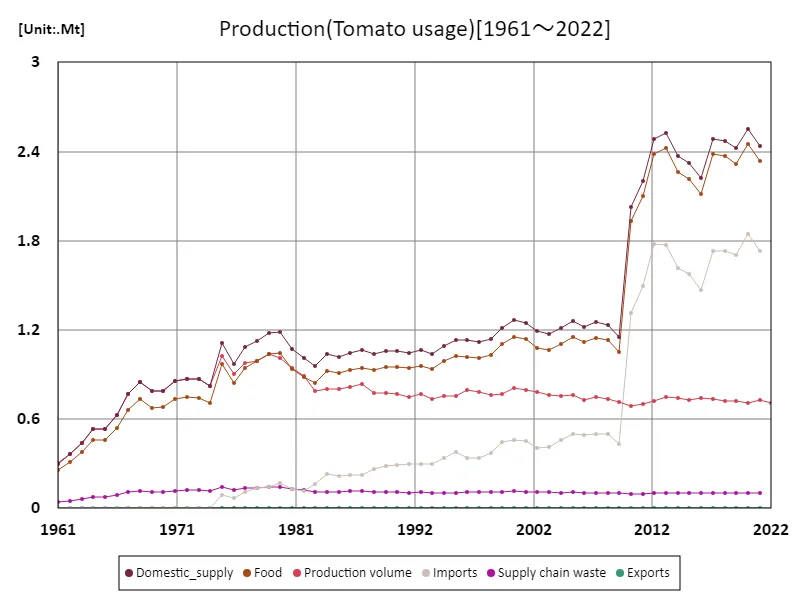

The maximum is 2.55Mt[2020] of Domestic_supply, and the current value is about 95.4%
Yield(by vegetable)
Looking at data on vegetable yields for Japan as a whole, cabbage recorded its highest yield of 70.1 tonnes per hectare (t/ha) in 2006, but has since been on a downward trend, currently standing at around 42.9 tonnes/ha, which is 61.3% of its peak. The background to this change is the evolution of agricultural technology and cultivation methods, and the accompanying changes in the production environment. The high yield of cabbage in the early 2000s is thought to be due to the efficient production that became possible through improved varieties and cultivation techniques, as well as the spread of agricultural machinery. However, the subsequent decline is due to a shrinking area of farmland, an aging agricultural workforce, and unstable growing conditions due to climate change. In particular, extreme weather conditions such as drought and heavy rain have a negative impact on harvests, leading to reduced yields. The decrease in cabbage production is also related to the diversification of consumer diets and changes in demand. In particular, the trend towards preferring other vegetables over cabbage and an increase in imported products are also contributing factors. However, in recent years, there has been a shift towards sustainable agriculture and the introduction of labor-saving technologies, and it is hoped that these technological innovations will contribute to the recovery of yields in the future.
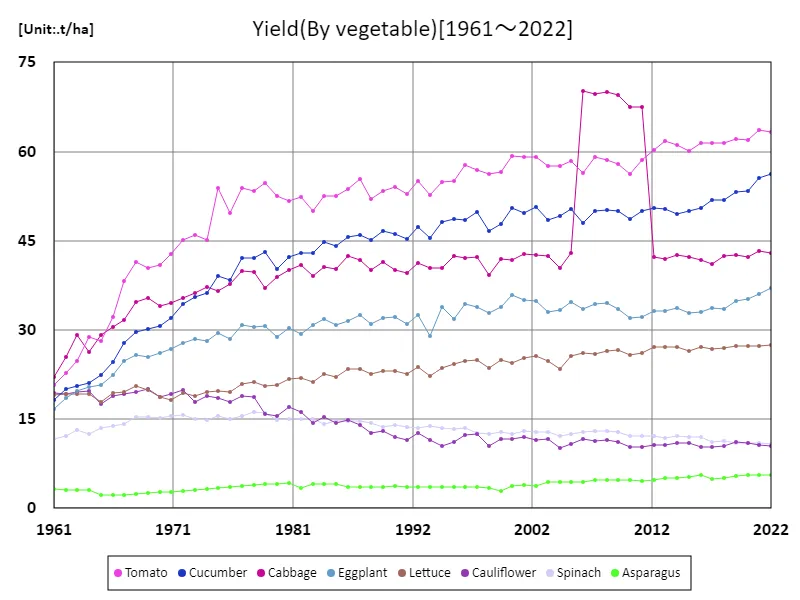

The maximum is 70.1t/ha[2006] of Cabbage, and the current value is about 61.3%
Land use (by vegetables)
Vegetable land use data for Japan in 2022 shows that cabbage is cultivated on the largest area, reaching 33.9 thousand hectares (kha). This accounts for approximately 27.2% of the total, showing how important cabbage is in Japan’s vegetable production. The average land use area for vegetables is 15,700 hectares, with a total of 125,000 hectares, of which cabbage stands out. As has been the trend up until now, cabbage has been widely cultivated throughout Japan, with large-scale cultivation occurring in major production areas such as Gunma, Chiba, and Ibaraki prefectures. High demand for cabbage and a stable consumer market support such widespread land use. However, in recent years, due to improved agricultural efficiency, urbanization, and a decrease in farmland, the area where cabbage is cultivated has been gradually shrinking. Nevertheless, cabbage continues to account for a large share of land use compared to other vegetables. Furthermore, Japanese agriculture is moving toward optimizing land use and introducing labor-saving technologies, and even for crops that are widely grown, such as cabbage, varieties are being improved and cultivation methods are being reviewed. In particular, adaptation technologies to deal with climate change and small-scale, highly efficient cultivation on the outskirts of cities are attracting attention. In the future, with the promotion of sustainable agriculture, we may see changes in the form of land use.
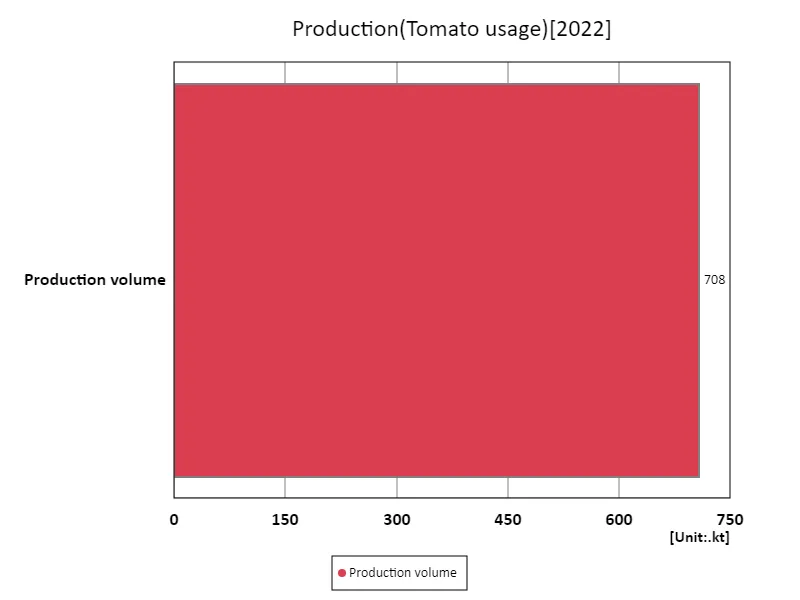

The maximum is 708kt of Production volume, the average is 708kt, and the total is 708kt
Tomato usage
Based on data from 1961, domestic supply of tomatoes reached 2.55 million tonnes (Mt), which is recorded as the maximum value to date. The background to this is that during this period, consumption of tomatoes increased sharply and demand for eating them raw increased. In terms of uses, tomatoes were overwhelmingly consumed raw, and were widely used at home and in restaurants, such as in salads and as a side dish. Since then, tomato production and consumption trends have diversified, with demand for tomatoes for processing in particular increasing. This led to the popularity of processed products such as ketchup, sauces and juices, and the production of tomatoes for processing also expanded. Since the 1970s, the growth of the restaurant and food processing industries, in addition to demand for fresh tomatoes at home, have become important factors supporting the tomato market. In recent years, the use of tomatoes has become more diverse, with increased demand for them as an ingredient in pizza and pasta, as well as increased consumption of tomatoes as raw foods and as juice due to growing health consciousness. On the other hand, due to the effects of global warming, increased agricultural efficiency, and the introduction of quality improvement technologies, the cultivation area and yields of tomatoes are also fluctuating. In Japanese agriculture, tomatoes are a crop that requires a flexible production system to meet the demand for each use, and it is expected that production that meets consumer needs will continue to increase in the future.
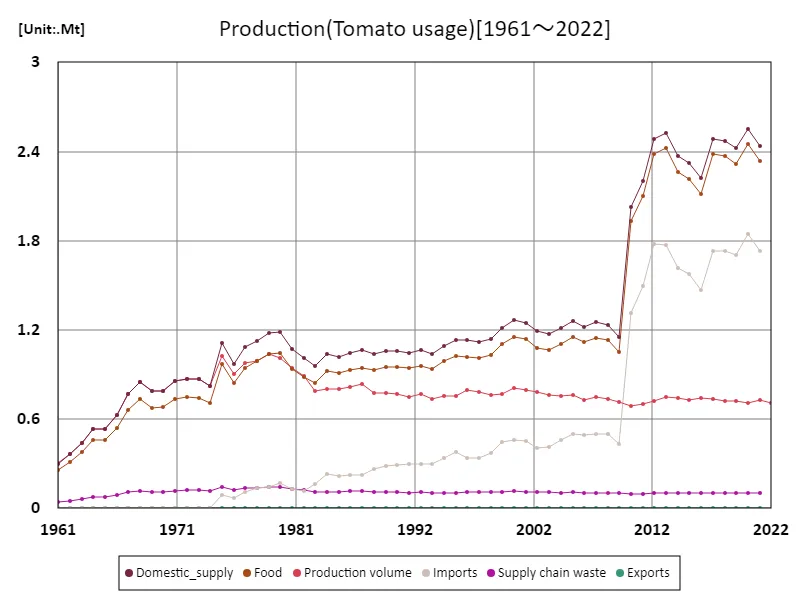

The maximum is 2.55Mt[2020] of Domestic_supply, and the current value is about 95.4%
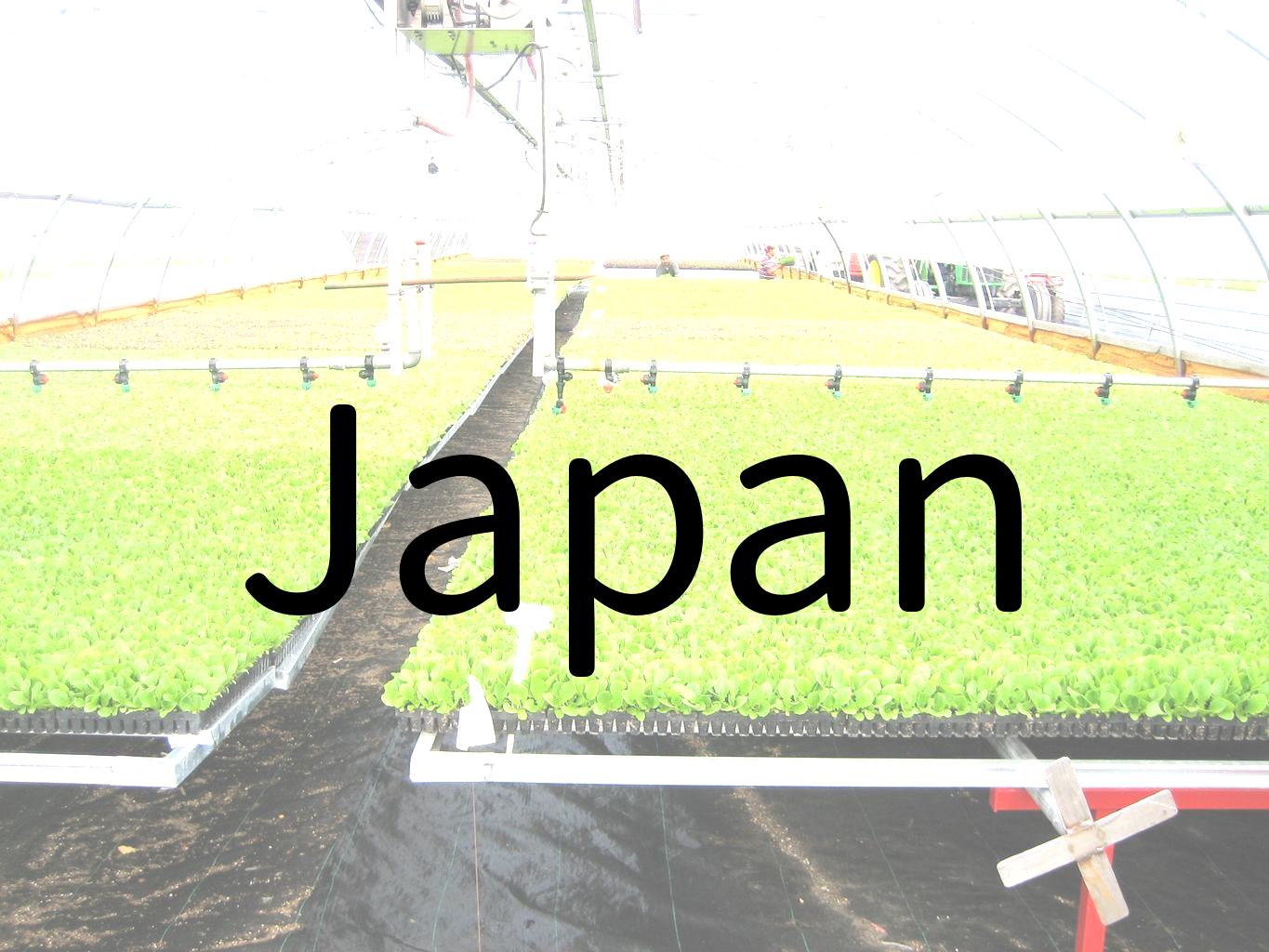


Comments